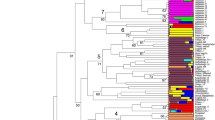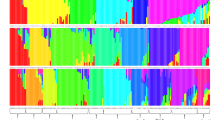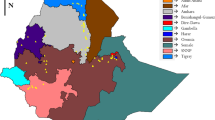Summary
Fifty-six accessions of cultivated and wild sorghum were surveyed for genetic diversity using 50 low-copy-number nuclear DNA sequence probes to detect restriction fragment length polymorphisms (RFLPs). These probes revealed greater genetic diversity in wild sorghum than in cultivated sorghum, including a larger number of alleles per locus and a greater portion of polymorphic loci in wild sorghum. In comparison to previously published isozyme analyses of the same accessions, RFLP analysis reveals a greater number of alleles per locus. Furthermore, many RFLP alleles have frequencies between 0.25–0.75, while the vast majority of isozyme alleles are either rare (< 0.25) or near fixation (> 0.75). Correlations between genetic and geographic distances among the accessions were stronger when calculated with RFLP than with isozyme data. Systematic relationships revealed by nuclear and chloroplast restriction site analysis indicate that cultivated sorghum is derived from the wild ssp. arundinaceum. The portion of the wild gene pool most genetically similar to the cultivars is from central-northeastern Africa. Previous published data also suggested that this is most likely the principal area of domestication of sorghum. Introgression between wild and cultivated sorghum was inferred from disconcordant relationships shown by nuclear and chloroplast DNA markers. Introgression apparently occurs infrequently enough that the crop and its wild relatives maintain distinct genetic constitutions.
Similar content being viewed by others
References
Aldrich PR, Doebley J, Schertz KF, Stec A (submitted) Patterns of allozyme variation in cultivated and wild Sorghum bicolor. Theor Appl Genet (1992) (accepted)
Bernatzky R, Tanksley SD (1989) Restriction fragments as molecular markers for germplasm evaluation and utilization. In: Brown AHD, Frankel OH, Marshall DR, Williams JT (eds) The use of plant genetic resources. Cambridge University Press, New York, pp 353–362
Clegg MT (1990) Molecular diversity in plant populations. In: Brown AHD, Clegg MT, Kahler AL, Weir BS (eds) Plant population genetics, breeding, and genetic resources. Sinauer Assoc, Mass., pp 98–115
Crawford DJ (1990) Plant molecular systematics: macromolecular approaches. John Wiley and Sons, New York
Dietz EJ (1983) Permutation test for association between two distance matrices. Syst Zool 32:21–26
Doebley JF (1989) Isozymic evidence and the evolution of crop plants. In: Soltis DE, Soltis PS (eds) Isozymes in plant biology. Dioscorides Press, Portland, Ore., pp 165–191
Doebley JF, Wendel JF (1989) Application of RFLPs to plant systematics. Current communications in molecular biology series. Cold Spring Harbor Laboratory Press, Cold Spring Harbor, N.Y.
Duvall MR, Doebley JF (1990) Restriction site variation in the chloroplast genome of Sorghum (Poaceae). Syst Bot 15:472–480
Feinberg AP, Vogelstein B (1983) A technique for radiolabelling DNA restriction endonuclease fragments to high specific activity. Anal Biochem 132:6–13
Harlan JR, Stemler ABL (1976) The races of sorghum in Africa. In: Harlan JR, de Wet JMJ, Stemler ABL (eds) Origins of African plant domestication. Mouton Press, The Hague, pp 465–478
Helentjaris T, King G, Slocum M, Siedenstrang C, Wegman S (1985) Restriction fragment polymorphisms as probes for plant diversity and their development as tools for applied plant breeding. Plant Mol Biol 5:109–118
Larrinua IM, Muskavitch EJ, Gubbins EJ, Bogorad L (1983) A detailed restriction endonuclease site map of the Zea mays plastid genome. Plant Mol Biol 2:129–140
Maniatis T, Fritsch EF, Sambrook J (1982) Molecular cloning: a laboratory manual. Cold Spring Harbor Laboratory Press Cold Spring Harbor, N. Y.
Mantel N, Valand RS (1970) A technique of nonparametric multivariate analysis. Biometrics 26:547–558
Morden CW, Doebley JF, Schertz KF (1989) Allozyme variation in old world races of Sorghum bicolor (Poaceae). Am J Bot 76:247–255
Morden CW, Doebley JF, Schertz KF (1990) Allozyme variation among the spontaneous species of Sorghum section Sorghum (Poaceae). Theor Appl Genet 80:296–304
Palmer JD, Jansen RK, Michaels HJ, Chase MW, Manhart JR (1988) Chloroplast DNA variation and plant phylogeny. Ann Mo Bot Gard 75:1180–1206
Saghai-Maroof MA, Soliman KM, Jorgensen RA, Allard RW (1984) Ribosomal DNA spacer-length polymorphisms in barley: Mendelian inheritance, chromosomal location, and population dynamics. Proc Natl Acad Sci USA 81:8014–8018
Wright S (1978) Evolution and the genetics of populations. (Variability within and among natural populations vol 4). University of Chicago Press, Chicago
Author information
Authors and Affiliations
Additional information
Communicated by A.R. Hallauer
Rights and permissions
About this article
Cite this article
Aldrich, P.R., Doebley, J. Restriction fragment variation in the nuclear and chloroplast genomes of cultivated and wild Sorghum bicolor . Theoret. Appl. Genetics 85, 293–302 (1992). https://doi.org/10.1007/BF00222873
Received:
Accepted:
Issue Date:
DOI: https://doi.org/10.1007/BF00222873




